Mycenae › Linear B Script » Ancient origins
Articles and Definitions › Contents
- Mycenae › Antique Origins
- Linear B Script › Ancient History
Ancient civilizations › Historical and archaeological sites
Mycenae › Antique Origins
Definition and Origins
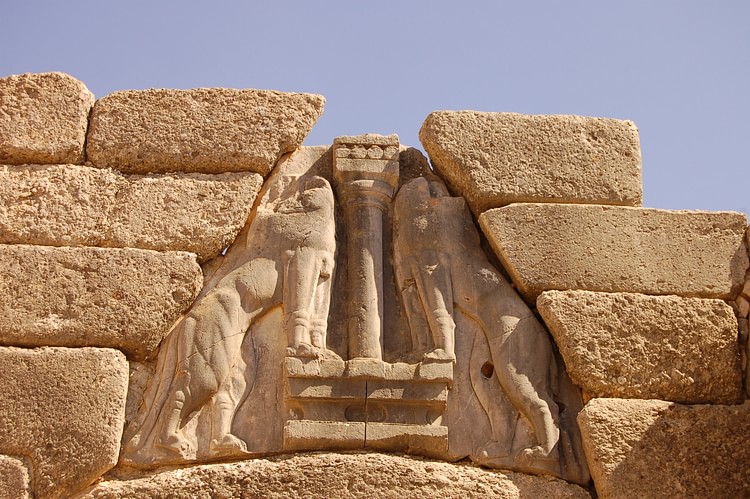
Mycenae was a fortified late Bronze Age city located between two hills on the Argolid plain of the Peloponnese, Greece.The acropolis today dates from between the 14th and 13th century BCE when the Mycenaean civilization was at its peak of power, influence and artistic expression.
IN MYTHOLOGY
In Greek mythology the city was founded by Perseus, who gave the site its name either after his sword scabbard ( mykes ) fell to the ground and was regarded as a good omen or as he found a water spring near a mushroom ( mykes ). Perseus was the first king of the Perseid dynasty which ended with Eurytheus (instigator of Hercules ' famous twelve labours). The succeeding dynasty was the Atreids, whose first king, Atreus, is traditionally believed to have reigned around 1250 BCE.Atreus' son Agamemnon is believed to have been not only king of Mycenae but of all of the Archaean Greeks and leader of their expedition to Troy to recapture Helen. In Homer ’s account of the Trojan War in the Iliad, Mycenae (or Mykene) is described as a 'well-founded citadel', as 'wide-wayed' and as 'golden Mycenae', the latter supported by the recovery of over 15 kilograms of gold objects recovered from the shaft graves in the acropolis.
HISTORICAL OVERVIEW
Situated on a rocky hill (40-50 m high) commanding the surrounding plain as far as the sea 15 km away, the site of Mycenae covered 30,000 square metres and has always been known throughout history, although the surprising lack of literary references to the site suggest it may have been at least partially covered. First excavations were begun by the Archaeological Society of Athens in 1841 CE and then famously continued by Heinrich Schliemann in 1876 CE who discovered the magnificent treasures of Grave Circle A. The archaeological excavations have shown that the city has a much older history than the Greek literary tradition described.
ATREUS' SON AGAMEMNON IS BELIEVED TO HAVE BEEN NOT ONLY KING OF MYCENAE BUT OF ALL OF THE ARCHAEAN GREEKS AND LEADER OF THEIR EXPEDITION TO TROY.
Inhabited since Neolithic times, it is not until c. 2100 BCE that the first walls, pottery finds (including imports from the Cycladic islands) and pit and shaft graves with higher quality grave goods appear. These, taken collectively, suggest a greater importance and prosperity in the settlement.
From c. 1600 BCE there is evidence of an elite presence on the acropolis: high-quality pottery, wall paintings, shaft graves and an increase in the surrounding settlement with the construction of large tholos tombs. From the 14th century BCE the first large-scale palace complex is built (on three artificial terraces), as is the celebrated tholos tomb, the Treasury of Atreus, a monumental circular building with corbelled roof reaching a height of 13.5 m and 14.6 m in diameter and approached by a long walled and unroofed corridor 36 m long and 6m wide. Fortification walls, of large roughly worked stone blocks, surrounding the acropolis (of which the north wall is still visible today), flood management structures such as dams, roads, Linear B tablets and an increase in pottery imports (fitting well with theories of contemporary Mycenaean expansion in the Aegean ) illustrate the culture was at its zenith.
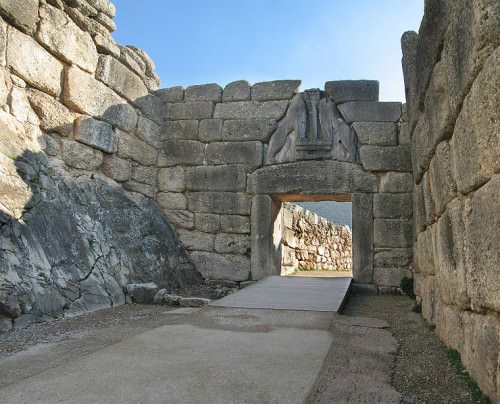
Lion's Gate at Mycenae
ARCHITECTURE
The large palace structure built around a central hall or Megaron is typical of Mycenaean palaces. Other features included a secondary hall, many private rooms and a workshop complex. Decorated stonework and frescoes and a monumental entrance, the Lion Gate (a 3 mx 3 m square doorway with an 18-ton lintel topped by two 3 m high heraldic lions and a columnaltar), added to the overall splendour of the complex. The relationship between the palace and the surrounding settlement and between Mycenae and other towns in the Peloponnese is much discussed by scholars. Concrete archaeological evidence is lacking but it seems likely that the palace was a centre of political, religious and commercial power. Certainly, high-value grave goods, administrative tablets, pottery imports and the presence of precious materials deposits such as bronze, gold and ivory would suggest that the palace was, at the very least, the hub of a thriving trade network.
The first palace was destroyed in the late 13th century, probably by earthquake and then (rather poorly) repaired. A monumental staircase, the North Gate, and a ramp were added to the acropolis and the walls were extended to include the Perseia spring within the fortifications. The spring was named after the city's mythological founder and was reached by an impressive corbelled tunnel (or syrinx ) with 86 steps leading down 18m to the water source. It is argued by some scholars that these architectural additions are evidence for a preoccupation with security and possible invasion. This second palace was itself destroyed, this time with signs of fire. Some rebuilding did occur and pottery finds suggest a degree of prosperity returned briefly before another fire ended occupation of the site until a brief revival in Hellenistic times. With the decline of Mycenae, Argos became the dominant power in the region. Reasons for the demise of Mycenae and the Mycenaean civilization are much debated with suggestions including natural disaster, over-population, internal social and political unrest or invasion from foreign tribes.
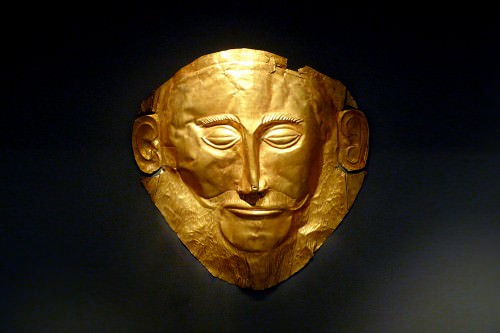
Death Mask of Agamemnon
ARTEFACTS
Celebrated artefacts from Mycenae include five magnificent beaten gold burial masks (one being incorrectly attributed to Agamemnon by Schliemann), gold diadems, carved rings, cups and a lion head rhyton. A magnificent bronze and gold rhyton in the form of a bull's head, large bronze swords and daggers with richly inlaid scenes on their blades, ivory sculpture and fragments of fresco also give testimony to the quality of craftsmanship and wealth of 'golden Mycenae'.
MAP
Linear B Script › Ancient History
Definition and Origins
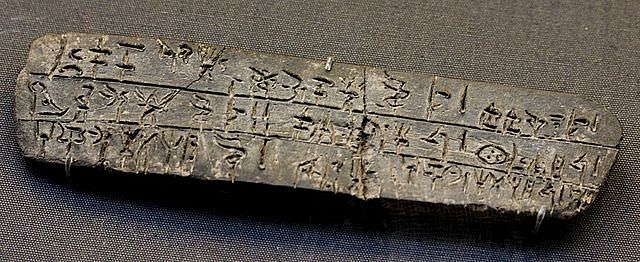
Linear B Script was the writing system used by the Mycenaean civilization. Examples of this script have been recovered from late Minoan II contexts in Crete and Mycenaean IIIA-B contexts in mainland Greece, which suggest that the script was in use between c. 1450 and c. 1100 BCE. The use of Linear B Script was restricted to major palace sites such as Knossos, Mycenae, Pylos, Thebes, and Tiryns. Most Linear B inscriptions are on clay tablets and largely concerned with documenting economic transactions of the palace administration, but we also have a few examples that relate to military activity.
LINEAR B IS THE OLDEST PRESERVED FORM OF WRITTEN GREEK THAT WE KNOW OF.
The Greeks were not the only ones who employed a syllabic writing system: several syllabic scripts were used by different contemporary Near-Eastern neighbours. The Linear B writing system is composed of 90 syllable signs plus an indeterminate number of pictorial signs. Each syllable sign represents either a vowel or an open syllable (consonant-vowel), but they cannot represent consonant clusters.
ORIGIN OF THE LINEAR B SCRIPT
Linear B is the oldest preserved form of written Greek that we know of. By the time we first meet this writing system, Greece and different areas of the western coast of Asia Minor were already Greek-speaking. Linear B was used to write an archaic form of Greek known as Mycenaean Greek, which was the official dialect of the Mycenaean civilization. The inscriptions found in Crete appear to be older than those discovered in mainland Greece. The oldest confirmed Linear B tablets are the so-called Room of the Chariot Tablets from Knossos and have been dated to c.1450-1350 BCE, while the tablets found at Pylos have been dated to c. 1200 BCE. This suggests that the Linear B script was devised in Knossos (Crete), somewhere around 1450 BCE when the Mycenaeans took control of Knossos, and spread from here to mainland Greece. Whether by peaceful annexation or armed invasion, we know that the Minoan culture was replaced, both in Crete and in mainland Greece, by the Mycenaean culture.
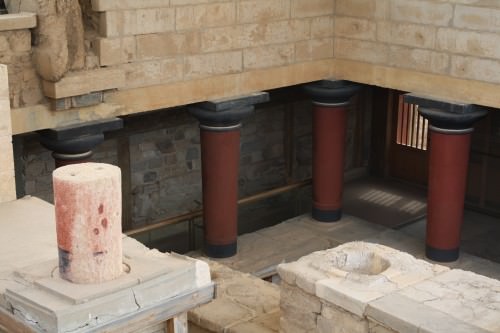
The Palace of Knossos
ALTHOUGH MOST LINEAR B DOCUMENTS CAN BE READ TODAY, SOME FEATURES OF THE WRITING SYSTEM REMAIN UNCLEAR. NOT ALL SYLLABLE SIGNS HAVE BEEN DETERMINED CONCLUSIVELY.
Long before the Mycenaeans took control of Knossos, the Minoan civilization had a writing system in use known as Linear A Script, which was employed to represent the official Minoan language. Nothing certain is known about the Minoan language.Its linguistic affiliation remains a mystery, but the general consensus is that the language was not Greek; probably it was not even part of the Indo-European languages. Since Linear B shares many signs with the older Linear A, it has been inferred that Linear B came into existence when the scribes adapted Linear A to a new language: Greek. This idea is further supported by the fact that Linear B is poorly suited to writing Greek. For instance, Linear B is unable distinguish between short and long vowels and between r and l. As a result, words like 'leuka' (white) had to be written as re-u-ka. Another difficulty relates to the fact that Linear B cannot represent consonant clusters. Therefore, names such as 'Knossos' had to be written as ko-no-so and words like 'aksone' (axes) or 'demnia' (bed clothes) had to be written a-ko-so-ne and de-mi-ni-a respectively. In some specific examples such as the word 'aiguptios' (Egyptian), written as a-ku-pi-ti-jo, the limitations of the script to represent Greek are fairly clear.
DECIPHERMENT & CONTENT OF THE LINEAR B SCRIPT
Although the first examples of Linear B texts were discovered early in the 20th century CE, these tablets were not published until 1952 CE. The meaning of Linear B texts remained surrounded by mystery until 1953 CE, the year when an architect named Michael Ventris managed to decipher the script. Ventris interpreted the script as an early form of Greek, which was unexpected since most scholars at that time believed that Linear B represented a form of Minoan language different from Greek. Although most Linear B documents can be read today, some features of the writing system remain unclear. Not all syllable signs have been determined conclusively.
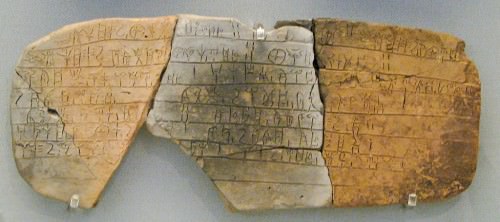
Linear B tablet
Linear B texts are mostly of an administrative nature, often under the form of lists of goods, statements of delivery, and records of commercial transactions. Tablets found at Pylos, for instance, provide details on the manufacture and distribution on palace-supervised commodities such as woollen and linen fabrics and perfume oils. Since the Mycenaean palaces performed not only an economic and political function but also a religious one, some of the deciphered Linear B texts are concerned with lists of religious offerings. These lists provide us with an idea of the type of items being offered (mainly foodstuff, including wine and olive oil) and also with the names of some of the gods and goddesses addressed. Interestingly, many of the names used in Mycenaean times were the same names used for the deities of the classical Greek world: Zeus, Hera, Poseidon, Hermes, Ares, Dionysos, and Artemis are just some examples. There is no certainty that there was cult continuity between Mycenaean times and classical times, but at least the names of several deities remained unchanged. A few examples of Linear B texts also mention chariots, armour, weapons, and soldiers getting ready for military campaigns.
DECLINE OF THE LINEAR B SCRIPT
After the collapse of the Mycenaean political order in c. 1200 BCE, the use of the Linear B script gradually diminished until it was fully abandoned around 1100 BCE. Literacy was completely lost in the Greek world until its return during the 8th century BCE, with the emergence of a new writing system: the Greek alphabet. The Linear B Script and the Greek alphabet are two completely different and unrelated writing systems, which reflects in a way how deeply Greece plunged into illiteracy and stagnation during the interval between the collapse of the Mycenaean civilization and the Greek Archaic period, a time known as the Greek Dark Age.
LICENSE:
Article based on information obtained from these sources:with permission from the Website Ancient History Encyclopedia
Content is available under License Creative Commons: Attribution-NonCommercial-ShareAlike 3.0 Unported. CC-BY-NC-SA License